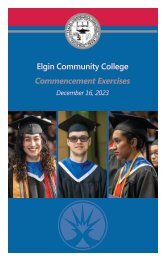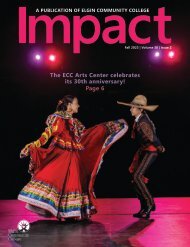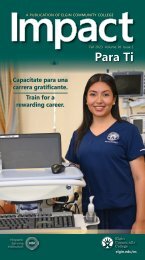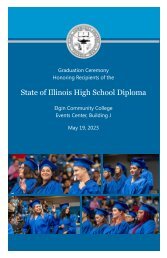ILEA Equity Plan | Elgin Community College (ECC)
There are wide and persistent gaps in college completion rates in Illinois, especially among students of color and low-income students. After an in-depth analysis of our institutional data, Elgin Community College (“ECC” or “the College” or “we” or “our”) has developed an Equity Plan containing annual growth targets for which progress updates will be shared publicly over the next five years. Our Equity Plan reflects the unique characteristics of our institution. For example, ECC is designated as a Hispanic Serving Institution by the US Department of Education, with just over 42% of the students identifying as Latinx or Hispanic. Also, the district served by ECC is widely diverse in terms of income and educational attainment. We will identify the obstacles students face and develop programs and policies that break down unnecessary college graduation barriers. Along with our fellow colleges, in the Partnership for College Completion organization, with this Illinois Equity in Attainment (“ILEA”) plan, we pledge to close the completion gaps by 2025.
There are wide and persistent gaps in college completion rates in Illinois, especially among students of color and low-income students. After an in-depth analysis of our institutional data, Elgin Community College (“ECC” or “the College” or “we” or “our”) has developed an Equity Plan containing annual growth targets for which progress updates will be shared publicly over the next five years. Our Equity Plan reflects the unique characteristics of our institution. For example, ECC is designated as a Hispanic Serving Institution by the US Department of Education, with just over 42% of the students identifying as Latinx or Hispanic. Also, the district served by ECC is widely diverse in terms of income and educational attainment. We will identify the obstacles students face and develop programs and policies that break down unnecessary college graduation barriers. Along with our fellow colleges, in the Partnership for College Completion organization, with this Illinois Equity in Attainment (“ILEA”) plan, we pledge to close the completion gaps by 2025.
Create successful ePaper yourself
Turn your PDF publications into a flip-book with our unique Google optimized e-Paper software.
student group’s current performance and the future target and divided the difference by the<br />
number of reporting years evenly. The increase from year to year is in equal intervals. It is<br />
likely, that real change may not happen in equal intervals, rather we will see slower movement<br />
early on as some strategies are further developed or not yet implemented, and in a few years<br />
start to see greater amounts of improvement.<br />
For example, the Table 8 depicts the first of <strong>ILEA</strong>’s benchmarks, i.e., credits accumulated first<br />
fall. Part-time Pell students are the highest demographic group for this benchmark when<br />
looking at part-time standing, and White students are the highest group for full-time standing.<br />
That is, 50% of the population of Pell students achieve the part-time threshold of at least 7<br />
hours set by <strong>ILEA</strong>, and 16% of White students achieve the threshold of at least 15 credits.<br />
Therefore, all other part-time student groups not at 50% have a gap to close, as do all other<br />
full-time student groups not at 16%. Over the course of the next five years, interim targets are<br />
set so that at the end of the five years, the target is 50% or 16%, no matter the starting point,<br />
for each student group.<br />
Table 8. Interim Benchmarks for Credits Accumulated First Fall<br />
Reporting<br />
Year<br />
Cohort<br />
African-<br />
American<br />
Students<br />
Credits accumulated first fall<br />
Part-time students (at least 7) Full-time students (at least 15)<br />
Latinx<br />
Students<br />
White<br />
Students<br />
Pell<br />
Students<br />
Non-Pell<br />
Students<br />
African-<br />
American<br />
Students<br />
Latinx<br />
Students<br />
White<br />
Students<br />
Pell<br />
Students<br />
The full set of targets and interim benchmarks for all seven of the leading indicators and<br />
completion metrics are in the Appendix.<br />
Non-Pell<br />
Students<br />
2019 Fall 2018 (benchmark year) 29% 37% 40% 50% 32% 6% 12% 16% 12% 15%<br />
2020 Fall 2019 33% 39% 42% 50% 35% 8% 13% 16% 13% 15%<br />
2021 Fall 2020 36% 41% 43% 50% 38% 9% 13% 16% 13% 15%<br />
2022 Fall 2021 40% 44% 45% 50% 41% 11% 14% 16% 14% 16%<br />
2023 Fall 2022 43% 46% 47% 50% 44% 13% 15% 16% 15% 16%<br />
2024 Fall 2023 47% 48% 48% 50% 47% 14% 15% 16% 15% 16%<br />
2025 Fall 2024 50% 50% 50% 50% 50% 16% 16% 16% 16% 16%<br />
Fall 2024 (Target)<br />
50% 16%<br />
(2024 targets were set to highest benchmark year value from any of selected cohorts.<br />
The target-setting demographic group is highlighted in red)<br />
27<br />
<strong>ILEA</strong> <strong>Equity</strong> <strong>Plan</strong><br />
Future Vision

















